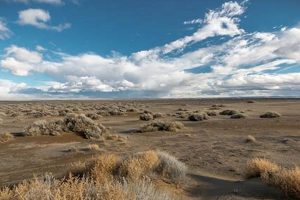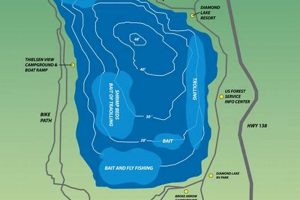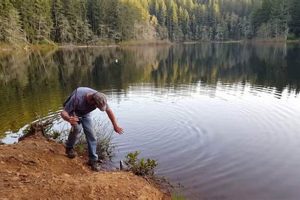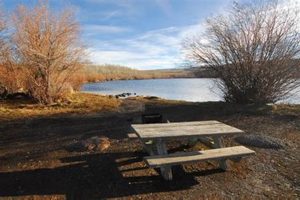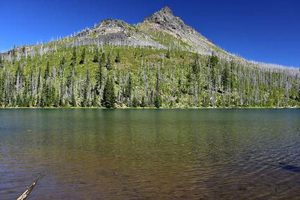The atmospheric conditions prevailing at East Lake, Oregon, a caldera lake situated in the Newberry National Volcanic Monument, are characterized by significant seasonal variations. Expect relatively mild and dry summers contrasted by cold, often snowy winters. Diurnal temperature swings can also be considerable due to the area’s high-desert climate and elevation. For example, July days frequently reach the 70s Fahrenheit, while nighttime temperatures can drop into the 40s.
Understanding the meteorological patterns of this region is crucial for recreational activities such as hiking, fishing, and camping. Awareness of potential hazards, including sudden snowstorms, particularly during the shoulder seasons (spring and fall), is essential for visitor safety. Historically, data collection related to temperature, precipitation, and wind speed has helped to inform resource management decisions within the Monument, including wildfire prevention and lake level monitoring.
The following sections will delve further into specific aspects of the climate near this Oregon lake, examining factors influencing precipitation patterns, typical temperature ranges throughout the year, and strategies for preparedness when visiting this location.
This section offers guidelines for responsible and safe engagement with the environment surrounding East Lake, Oregon, emphasizing awareness and preparation.
Tip 1: Monitor Conditions Regularly: Prior to and during visits, consult reliable sources such as the National Weather Service for up-to-date forecasts specific to the Newberry National Volcanic Monument. Weather can shift rapidly in this high-elevation environment.
Tip 2: Prepare for Variable Temperatures: Pack layers of clothing appropriate for a wide temperature range. Even during summer months, nighttime temperatures can drop significantly. Include moisture-wicking base layers, insulating mid-layers, and a waterproof outer shell.
Tip 3: Be Aware of Precipitation Patterns: Rainfall is more common during the spring and fall. Snow is possible from late fall through early spring. Carry rain gear and waterproof footwear, even if precipitation is not immediately forecast.
Tip 4: Protect Against Sun Exposure: The high altitude results in increased ultraviolet radiation. Use sunscreen with a high SPF, wear sunglasses with UV protection, and consider a wide-brimmed hat.
Tip 5: Account for Wind Conditions: Wind can significantly impact perceived temperature and increase the risk of hypothermia. Pay attention to wind forecasts and choose sheltered areas for activities when possible.
Tip 6: Check Road Conditions: Roads leading to East Lake may be subject to closures due to snow or ice. Check with the Oregon Department of Transportation for current road conditions before traveling.
Tip 7: Understand Lightning Risks: Thunderstorms can develop rapidly, particularly during the summer. Seek shelter indoors or in a vehicle if lightning is present. Avoid open areas, tall trees, and bodies of water.
Adhering to these tips enhances the safety and enjoyment of recreational experiences at East Lake, Oregon, while minimizing the potential for negative impacts related to potentially hazardous atmospheric conditions.
The subsequent section will provide a concluding summary of the key points discussed in this article.
1. Seasonal Temperature Swings
Seasonal temperature swings represent a defining characteristic of the atmospheric conditions at East Lake, Oregon. These variations are not merely background data; they exert significant influence on the ecology, hydrology, and recreational usability of the area. The annual cycle moves from relatively mild, dry summers, characterized by average daytime temperatures in the 70s Fahrenheit and nighttime temperatures potentially dipping into the 40s, to cold, snowy winters where temperatures frequently fall below freezing. This broad range is attributable to the area’s high-desert climate, elevation within the Newberry National Volcanic Monument, and the influence of continental air masses.
The impact of these temperature swings is multifaceted. For instance, the timing and extent of snowmelt directly affect lake levels and streamflow patterns, which are crucial for aquatic habitats and downstream water availability. In summer, the warm days and cool nights create favorable conditions for hiking, camping, and fishing, but also elevate the risk of wildfires due to dry vegetation. Conversely, the cold winters limit access to the lake and surrounding areas, primarily impacting winter recreation and necessitating careful monitoring of road conditions. The magnitude of these temperature variations further complicates the management of natural resources within the Monument, requiring adaptable strategies for wildfire prevention, water resource allocation, and habitat conservation.
In conclusion, the considerable seasonal temperature swings are an integral aspect of the environment near East Lake, Oregon, shaping its ecological dynamics and recreational opportunities. A comprehensive understanding of these temperature fluctuations is paramount for effective resource management and informed decision-making concerning visitor safety and environmental stewardship. The challenges posed by these variations necessitate continuous monitoring and proactive adaptation to ensure the sustainable use and preservation of this unique high-desert ecosystem.
2. Precipitation Patterns
Precipitation patterns are a critical determinant of environmental conditions at East Lake, Oregon, influencing lake levels, vegetation, and overall ecosystem health. The timing, form (rain or snow), and amount of precipitation significantly shape the character of this high-desert environment. The subsequent points detail specific facets of precipitation and its impact on the region.
- Annual Precipitation Amount
East Lake receives a moderate amount of precipitation annually, much of it falling as snow during the winter months. The precise amount varies from year to year, but this annual total is essential for replenishing the lake and maintaining groundwater levels. Deficits in annual precipitation can lead to lower lake levels and increased stress on vegetation, while excessive amounts can contribute to flooding and erosion.
- Seasonal Distribution
The majority of precipitation at East Lake occurs during the late fall, winter, and early spring. Summers tend to be relatively dry. This seasonal distribution means that the lake’s water levels are typically at their highest in the spring following snowmelt and gradually decline throughout the summer and fall. This pattern affects water availability for wildlife, recreational users, and potentially downstream ecosystems.
- Form of Precipitation
The high elevation of East Lake means that a significant portion of the annual precipitation falls as snow. The snowpack acts as a natural reservoir, slowly releasing water during the spring and summer months. Changes in snowfall patterns due to climate change, such as reduced snowpack or earlier melt, can have profound consequences for water availability and ecosystem function. Rain-on-snow events can also increase flood risk.
- Influence of Orographic Lift
The Cascade Mountains, including the Newberry Volcano where East Lake is located, influence precipitation patterns through orographic lift. As air masses are forced to rise over the mountains, they cool, and precipitation increases. This phenomenon contributes to the relatively higher precipitation levels in the vicinity of East Lake compared to surrounding lower-elevation areas. The presence of the volcano also affects local wind patterns, which can further influence precipitation distribution.
In summary, the interplay of annual amount, seasonal distribution, form, and orographic influences creates a complex precipitation regime that profoundly impacts East Lake, Oregon. Understanding these patterns is essential for informed water resource management, ecological conservation, and adaptation to potential climate change impacts within the Newberry National Volcanic Monument. Monitoring these precipitation patterns will be important to future sustainability.
3. High-Altitude Sun Exposure
The intensity of solar radiation is amplified at higher elevations, a characteristic of the environment surrounding East Lake, Oregon, thereby making “high-altitude sun exposure” a significant component of the atmospheric conditions prevailing there. This increased solar radiation necessitates heightened awareness and preventative measures for visitors and impacts various aspects of the local ecosystem.
- Increased UV Radiation
The thinner atmosphere at higher altitudes provides less protection from ultraviolet (UV) radiation. This results in a greater flux of UV rays reaching the Earth’s surface. For individuals at East Lake, this translates to a higher risk of sunburn, premature skin aging, and skin cancer with prolonged exposure, even on cloudy days. The risk is further intensified by reflection off snow or water surfaces.
- Impact on Vegetation
Elevated levels of UV radiation can stress vegetation, particularly young or sensitive plants. It can damage plant DNA, inhibit photosynthesis, and alter plant growth patterns. Some plant species are more tolerant of high UV levels than others, leading to shifts in species composition and distribution within the East Lake ecosystem. This can affect the availability of forage for wildlife and overall ecosystem stability.
- Effects on Aquatic Ecosystems
UV radiation can penetrate into the surface layers of East Lake, affecting aquatic organisms such as phytoplankton and zooplankton, which form the base of the food web. High UV levels can inhibit their growth and reproduction, potentially disrupting the entire aquatic ecosystem. Some species have developed protective mechanisms, such as UV-absorbing pigments, but these may not be sufficient to fully mitigate the effects of increased radiation.
- Ozone Layer Thickness
The thickness of the ozone layer, which absorbs a significant portion of UV radiation, varies geographically and seasonally. While not directly controlled by local conditions, fluctuations in ozone layer thickness can influence the amount of UV radiation reaching East Lake. Monitoring ozone levels and understanding their impact on UV radiation is important for assessing long-term environmental changes and potential health risks.
The heightened solar radiation at East Lake, Oregon, driven by its high altitude, interacts with various components of the local environment, influencing human health, vegetation patterns, and aquatic ecosystems. Awareness of the specific risks associated with increased UV exposure and the adoption of appropriate protective measures are essential for visitors and for the sustainable management of this unique high-desert environment.
4. Sudden Weather Changes
The propensity for abrupt atmospheric shifts represents a crucial aspect of conditions prevailing at East Lake, Oregon. This characteristic stems from a confluence of geographical and meteorological factors, impacting both recreational activities and ecosystem dynamics. Comprehending the nature and drivers of these rapid transformations is vital for preparedness and risk management in this environment.
- Influence of Topography
The complex terrain surrounding East Lake contributes to localized weather patterns and increased susceptibility to sudden changes. The presence of the Newberry Volcano, with its varied elevations and slopes, can induce localized wind patterns, including gusty conditions and rapid temperature fluctuations. Air masses moving across this terrain are subject to lifting and cooling, which can trigger the formation of clouds and precipitation, sometimes unexpectedly and intensely.
- Rapid Frontal Passages
East Lake is situated in a region where cold fronts can move through with relative frequency, particularly during the spring and fall. The passage of these fronts can result in abrupt shifts in wind direction and speed, temperature drops, and the onset of precipitation. These changes can occur within a matter of hours or even minutes, posing challenges for those engaged in outdoor activities.
- Development of Convective Storms
During the summer months, conditions are often favorable for the development of convective thunderstorms. These storms can form rapidly and produce heavy rain, hail, lightning, and strong winds. The isolated nature of these storms means that one area may experience intense conditions while a nearby location remains unaffected. The unpredictable nature of these events requires constant monitoring of forecasts and vigilance while outdoors.
- Lake Effect Enhancement
While East Lake is not a Great Lake, its presence can exert a localized influence on weather conditions, particularly during the colder months. The lake can act as a heat source, modifying the air masses passing over it. This can result in enhanced precipitation downwind of the lake, including localized snow squalls. The intensity of this effect depends on the temperature difference between the lake water and the overlying air.
In summation, the potential for rapid shifts in atmospheric conditions is intrinsic to East Lake, Oregon, due to the interplay of terrain, frontal systems, convective activity, and localized lake effects. Awareness of these factors and the ability to anticipate and respond to sudden changes are essential for ensuring safety and minimizing potential disruptions in this dynamic environment. These insights further underscore the importance of detailed weather monitoring and proactive decision-making.
5. Wind Impact
Wind exerts a significant influence on conditions at East Lake, Oregon, shaping various aspects of the lake’s environment and impacting activities in the area. The interaction between wind patterns and the region’s topography creates unique meteorological effects. Prevailing winds, often channeled by the surrounding caldera walls, can result in localized areas of increased wind speed. This phenomenon affects the distribution of snow during winter, leading to drifts and uneven snowpack accumulation, which, in turn, impacts spring runoff and lake levels. Strong winds can also increase evaporative losses from the lake surface, particularly during the warmer months, influencing water availability. Wind’s role extends beyond just water cycles; it plays a critical part in fire risk, as strong, dry winds can rapidly spread wildfires, a significant concern in the high-desert environment.
The impact of wind extends to recreational activities as well. High winds can create challenging conditions for boating, kayaking, and fishing on East Lake, potentially leading to hazardous situations. Campers and hikers must also consider wind conditions when selecting campsites or planning routes, as exposed areas can experience significantly stronger winds than sheltered locations. Accurate wind forecasts are crucial for making informed decisions about outdoor activities and ensuring safety. Furthermore, wind also plays a role in distributing seeds and pollen, influencing plant distribution and ecosystem dynamics around the lake. For example, wind-dispersed seeds can colonize disturbed areas following wildfires, contributing to the regeneration of vegetation.
Understanding wind’s role is paramount for predicting weather patterns, managing natural resources, and ensuring public safety at East Lake, Oregon. Challenges remain in accurately forecasting localized wind conditions due to complex terrain interactions. Continued monitoring and research efforts are essential for improving predictive models and informing management decisions, highlighting the inextricable link between atmospheric forces and the health, safety, and recreational opportunities surrounding this unique caldera lake.
6. Road Accessibility
Road accessibility to East Lake, Oregon, is inextricably linked to the prevailing meteorological conditions of the region. Weather dictates the feasibility of travel, influencing both safety and convenience for visitors and impacting resource management activities. The following details outline key facets of this relationship.
- Seasonal Closures
During winter, heavy snowfall and ice accumulation frequently lead to the closure of roads leading to East Lake. Oregon Department of Transportation (ODOT) often implements closures to ensure public safety. These closures can persist for extended periods, severely limiting access to the lake and surrounding areas. Understanding historical snowfall data and monitoring current weather forecasts are crucial for predicting and managing these closures.
- Road Maintenance Operations
Maintaining road accessibility during periods of inclement does necessitate intensive maintenance efforts. Plowing, sanding, and de-icing operations are essential for keeping roadways passable. The frequency and intensity of these operations are directly correlated with the amount and type of precipitation, as well as temperature fluctuations. Insufficient maintenance can lead to hazardous driving conditions, increasing the risk of accidents.
- Vehicle Requirements
Specific vehicle requirements may be imposed during periods of adverse . Chains or traction tires may be mandated for vehicles traveling to East Lake, particularly on steep or winding sections of the road. These requirements are designed to improve traction and reduce the likelihood of vehicles losing control. Failure to comply with these regulations can result in fines or restrictions on travel.
- Impact on Emergency Services
Weather-related road closures and hazardous driving conditions can significantly impede the ability of emergency services to access East Lake. Response times for medical emergencies, search and rescue operations, and wildfire suppression efforts may be substantially increased. Contingency plans and alternative access routes are essential for mitigating these risks.
These interconnected factors highlight the sensitivity of transportation infrastructure to the dynamics near East Lake, Oregon. Planning trips needs to consider the influence of current atmospheric forecasts and potential impacts on accessibility, underlining the need for diligent preparation and risk awareness for anyone traveling to or within the vicinity.
7. Lightning Risk
Lightning risk constitutes a significant element of atmospheric hazards associated with East Lake, Oregon. The geographic location and meteorological patterns converge to create conditions conducive to thunderstorm development, thereby elevating the potential for lightning strikes. Convective thunderstorms, frequently arising during summer afternoons, result from atmospheric instability and moisture availability. These storms can quickly escalate, producing frequent and dangerous lightning. The high elevation of East Lake further exacerbates the risk, as the thinner atmosphere offers less resistance to electrical discharge.
Several real-life incidents underscore the tangible nature of this threat. Hikers and campers in the Newberry National Volcanic Monument, including areas around East Lake, have been struck by lightning, resulting in injuries and, in some cases, fatalities. Open areas, such as shorelines and exposed ridges, increase vulnerability. Sheltering under trees is notably dangerous due to the risk of side flashes or ground current. Understanding lightning behavior and implementing appropriate safety measures are crucial for mitigating risk. For instance, monitoring weather forecasts, seeking shelter indoors or in a hard-topped vehicle, and avoiding open areas during storms are practical preventative actions.
In summary, lightning risk is a substantial and predictable component of the environment surrounding East Lake, Oregon. It is essential to understand this risk profile to ensure visitor safety and guide resource management decisions. Ongoing monitoring of atmospheric conditions, coupled with public education initiatives, represents a vital strategy for minimizing lightning-related incidents and promoting responsible recreation within the area.
Frequently Asked Questions
This section addresses common inquiries regarding atmospheric conditions at East Lake, Oregon, providing concise and authoritative information.
Question 1: Is the region around East Lake, Oregon, prone to sudden shifts in atmospheric conditions?
Yes, East Lake experiences frequent and sometimes rapid weather changes, particularly during spring and fall. These shifts can include significant temperature drops, strong winds, and the onset of precipitation, including snow, even during the warmer months.
Question 2: What months typically present the most favorable meteorological conditions for visiting East Lake?
July and August generally offer the most stable conditions with warmer temperatures and less precipitation. However, even during these months, visitors should be prepared for potential afternoon thunderstorms and significant diurnal temperature variations.
Question 3: Are there specific road closures to East Lake due to conditions?
Yes, roads leading to East Lake are subject to seasonal closures due to heavy snowfall and ice accumulation. These closures typically occur from late fall to early spring. Travelers should consult the Oregon Department of Transportation website for current road conditions and closure information.
Question 4: What precautions are recommended to mitigate the heightened solar radiation at East Lake?
Due to its high altitude, East Lake experiences increased ultraviolet (UV) radiation. Visitors should use sunscreen with a high SPF, wear sunglasses with UV protection, and wear a wide-brimmed hat to minimize sun exposure. Prolonged exposure, especially during peak sunlight hours, should be avoided.
Question 5: What is the likelihood of encountering lightning storms around East Lake?
Thunderstorms, often accompanied by lightning, are relatively common during the summer months. Visitors should monitor forecasts closely and seek shelter indoors or in a vehicle during thunderstorms. Open areas, tall trees, and bodies of water should be avoided during electrical storms.
Question 6: How does wind impact conditions at East Lake?
Wind can significantly influence temperatures, particularly during colder months, increasing the risk of hypothermia. Strong winds can also create hazardous conditions for boating and other water activities. Sheltered areas should be selected for camping and other outdoor activities whenever possible.
In conclusion, East Lake presents a dynamic atmospheric environment requiring preparedness and awareness. Monitoring forecasts, understanding potential hazards, and taking appropriate precautions enhance the safety and enjoyment of recreational experiences.
The next section will provide a list of external resources for accessing data and planning a trip to East Lake.
East Lake Oregon Weather
This examination of the atmospheric environment at East Lake, Oregon, has highlighted the significance of understanding prevailing . The confluence of seasonal temperature variations, precipitation patterns, high-altitude solar exposure, potential for abrupt atmospheric shifts, wind impact, road accessibility contingencies, and lightning risks collectively defines the climatic characteristics of this location. A comprehensive grasp of these interconnected elements is essential for risk mitigation and informed decision-making.
Effective stewardship of natural resources and ensuring visitor safety demand continuous observation and analysis of the atmospheric conditions near East Lake. Subsequent investigations should focus on refining predictive models to anticipate and respond to shifts, ensuring both preservation of this unique ecosystem and the well-being of those who engage with it.


